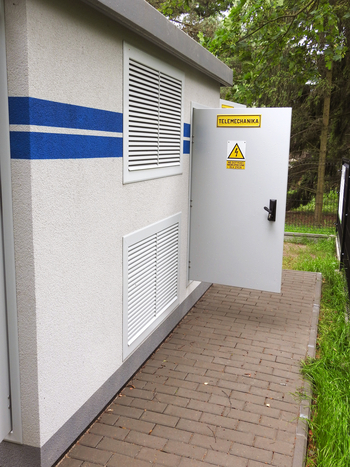The aim of the project introduced in the Municipality of Dąbrowa Chełmińska, within the area of Distribution Area in Bydgoszcz, was to build a smart network, modernise it and reconstruct its power supply. The existing poles were equipped with microBEL SRS controllers, while the newly built container station was fitted with automation based on the microBEL SX controller.
The microBEL SX device serves as a short-circuit current flow indicator, as well as measures and controls MV lines. The microBEL ARN controller is the heart of the station, which, thanks to measurements of voltage on the LV station busbars and LV line outlets by means of elevated controllers – microBEL SENS with ECOTAP VPD tap changer made by Reinhausen, is able to regulate the voltage with transformer taps. The regulation takes place depending on the load of the LV line by consumers.
The microBEL ARN algorithm first regulates the voltage on the busbars of the LV switchgear of the transformer station so that the average value, calculated based on the voltages from the individual phases, corresponds to the preset value. At this stage, the voltages from sensors installed deep in the network are not taken into account.
 When the average voltage on the busbars falls within the specified limits, the next step is to check whether the voltages on the individual phases are within the specified range. If the voltage on any phase is found to be outside the permissible range, the algorithm calculates whether a change in the tap changer's position that would eliminate this discrepancy will not cause the voltage of other phases to exceed the permissible range.
When the average voltage on the busbars falls within the specified limits, the next step is to check whether the voltages on the individual phases are within the specified range. If the voltage on any phase is found to be outside the permissible range, the algorithm calculates whether a change in the tap changer's position that would eliminate this discrepancy will not cause the voltage of other phases to exceed the permissible range.
If the algorithm estimates that the voltages will lie within the expected range after changing the tap changer's position, the control is executed, causing the tap changer's position to be changed. At this stage, the voltages from sensors installed deep in the network are not taken into account. If phase voltages on the busbars remain within the specified limits, the next step is to check whether the average values of the phase voltages measured by sensors deep inside the network lie within the limit.
If the average voltage of any of the sensors does not meet this condition, an evaluation is carried out to determine whether the permitted phase voltages on the busbars and the average voltages of the other sensors can be exceeded by changing the position of the tap changer to correct the deviation of the voltage to the setpoint value. If the above condition can be fulfilled, the control is executed.
The algorithm provides for under-voltage and over-voltage interlocks that control the phase voltages at all measurement points, i.e. both the phase voltages on the busbars of the LV switchgear and the phase voltages from the elevated measurement sensors (microBEL SENS). The voltage asymmetry, defined as the largest deviation of the phase voltage from the average value, is checked on the busbars of the LV switchgear.
The foregoing describes the first part of a pilot project carried out under the Operational Programme Infrastructure and Environment 2014-2020, Measure 1.4: "Developing and implementing low and medium voltage smart distribution systems from the 2014 - 2020 Cohesion Fund perspective".
The experience gained by Apator Group during the above-mentioned work will be translated into other projects concerning the implementation and development of innovative solutions, also during the construction of smart power grids, taking into account the dynamically developing renewable energy sources.
